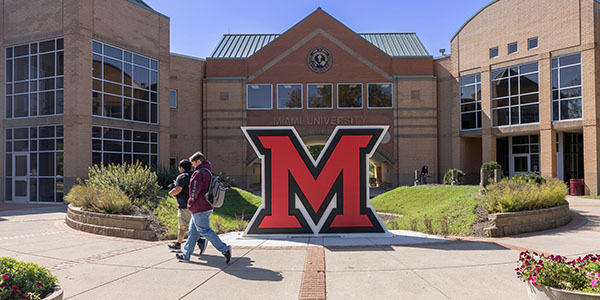Polytechnic campus builds on strengths of Miami Regionals
Initiative is part of first wave of MiamiTHRIVE strategic plan

Polytechnic campus builds on strengths of Miami Regionals
First announced during Miami University President Gregory Crawford’s spring update on April 2, the polytechnic campus is part of the first wave of initiatives from MiamiTHRIVE, the university’s strategic planning process.
Building on the existing partnership with Butler Tech Career Technical Center in the area of advanced manufacturing, the Miami University polytechnic campus will provide access for students across the region to pursue an applied, industry-driven and technology focused education, rooted in the liberal arts.
The polytechnic campus will blend applied learning, technical education, and industry collaboration coupled with a strong liberal education focused on workplace ready skills including communication, critical thinking, and the ability to work in teams.
“If you look at the workforce demands in southwest Ohio, a polytechnic campus really resonates with what this area needs,” President Crawford said. “The concept captures the strengths of Miami Regionals and ensures our graduates are well-educated and highly competitive in the workforce. I’m grateful to the committee that thoughtfully created this initiative to strategically leverage the Regionals campuses and align them with the future needs of our students and our communities.”
The polytechnic campus initiative is still in the early planning phases, and the shift is expected to happen over the course of the next few years. Initial research is currently being conducted, including exploring partnerships with industry and government leaders and other stakeholders to develop an implementation plan.
Current Miami Regionals students will not see any changes in their degree paths, and current majors and programs offered at the regional campuses are expected to continue. Like students of Miami Regionals, graduates from the polytechnic campus will receive a Miami University degree.
Ande Durojaiye, vice president for strategy and partnerships, said the applied learning of Miami’s polytechnic campus will be infused across all disciplines, creating a direct impact on students, the community, and the economy.
“Together, we get to design a future where each of our programs will benefit from strong industry partnerships and experiential and work-based learning,” Durojaiye said. “A polytechnic model helps us take a significant step toward aligning our education with industry demands, which creates many positive outcomes for all involved.”
The model also provides a great value for students, with a clearer path toward more industry-focused, hands-on learning opportunities.
“Miami can lead the way in Ohio by showcasing innovation in action every day,” Durojaiye said. “We can help shape the future of higher education and set a high standard for applied learning and workforce readiness.”
Students will graduate with real-world experience, technical skills, and having participated in work-based learning opportunities, including co-ops and internships, each semester. Close collaboration with businesses will also lead to stronger job placement opportunities, employer-sponsored programs, increased funding, research partnerships, and cutting-edge curriculum that will keep the campus forward-thinking and relevant.
“The demand for skilled workers is accelerating across every sector, and Miami University’s announcement to establish Ohio’s polytechnic campus represents a pivotal step in preparing students that are workforce-ready for today’s most in-demand careers,” said Kimm Lauterbach, president and CEO of REDI Cincinnati, which serves as the first point of contact for companies considering the Cincinnati region. “This initiative significantly strengthens our region’s robust STEM talent pipeline — powering REDI’s strategic industries of life sciences, aerospace and aviation, food, flavoring and beverage, and chemicals and materials.”
T.C. Rogers, Butler County commissioner, was in attendance during President Crawford’s spring update. Rogers said he left the event excited by what was unveiled for MiamiTHRIVE, including the upcoming polytechnic campus.
“You always have to be ready for the next new thing. It’s going to encourage invention and innovation with the benefit of real-world application,” Rogers said. “And after students have success, hopefully they will stay in Butler County. One of the measurements of my worth as a commissioner is how many kids I can get to stay in Butler County after graduation. When you have these entrepreneurial efforts, that’s where we can help them grow and stay here.”
In November, Miami announced its partnership with Butler Tech to create the Advanced Manufacturing Workforce and Innovation Hub.
Through the hub, Miami polytechnic will add associate degrees, industry-recognized credentials, and bachelor’s degrees in in-demand fields like robotics and technology to Miami Regionals’ current catalogue of 30-plus degree programs.
“Partnerships like our relationship with Butler Tech are a vital component to our success,” President Crawford said. “This dynamic approach will benefit students and our community for generations to come as we build a thriving and sustainable future with the Miami University polytechnic campus.”